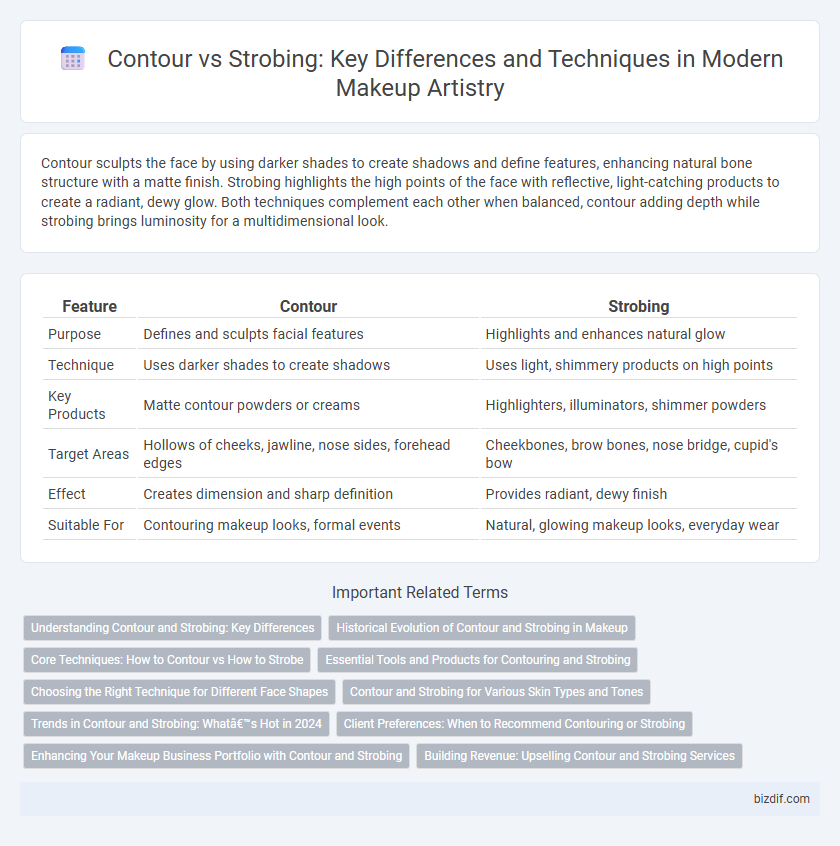Contour sculpts the face by using darker shades to create shadows and define features, enhancing natural bone structure with a matte finish. Strobing highlights the high points of the face with reflective, light-catching products to create a radiant, dewy glow. Both techniques complement each other when balanced, contour adding depth while strobing brings luminosity for a multidimensional look.
Table of Comparison
| Feature | Contour | Strobing |
|---|---|---|
| Purpose | Defines and sculpts facial features | Highlights and enhances natural glow |
| Technique | Uses darker shades to create shadows | Uses light, shimmery products on high points |
| Key Products | Matte contour powders or creams | Highlighters, illuminators, shimmer powders |
| Target Areas | Hollows of cheeks, jawline, nose sides, forehead edges | Cheekbones, brow bones, nose bridge, cupid's bow |
| Effect | Creates dimension and sharp definition | Provides radiant, dewy finish |
| Suitable For | Contouring makeup looks, formal events | Natural, glowing makeup looks, everyday wear |
Understanding Contour and Strobing: Key Differences
Contour sculpts the face by using darker shades to create shadows, enhancing natural bone structure and defining features like cheekbones and jawline. Strobing highlights the high points of the face such as cheekbones, brow bones, and the nose with lighter, luminous products to achieve a radiant, dewy glow. While contouring emphasizes depth and dimension through shading, strobing focuses on brightness and light reflection to create a fresh, illuminated complexion.
Historical Evolution of Contour and Strobing in Makeup
Contour techniques originated in the early 20th century with stage actors using dark and light makeup to shape facial features under harsh lighting, evolving significantly through the 1990s with the influence of celebrity makeup artists popularizing sculpted, chiseled looks. Strobing emerged in the 2010s as a response to contouring's complexity, focusing on illuminating high points of the face with highlighter to create a dewy, radiant glow reflecting a natural aesthetic trend. Both techniques reflect shifts in beauty standards and advances in makeup products, with contour emphasizing shadow and dimension, while strobing highlights luminosity and youthful vibrance.
Core Techniques: How to Contour vs How to Strobe
Contour involves using matte powders or creams to create shadows that sculpt and define facial features, typically applied along the hollows of the cheeks, jawline, and sides of the nose for a slimming effect. Strobing focuses on highlighting the high points of the face--such as the cheekbones, brow bones, bridge of the nose, and cupid's bow--using luminous, shimmery products to enhance natural radiance. Mastering contour requires precise blending to avoid harsh lines, while strobing depends on strategic placement of light-reflecting formulas to achieve a dewy, glowing complexion.
Essential Tools and Products for Contouring and Strobing
Contour requires matte bronzers, contour powders, or cream sticks in shades slightly darker than the natural skin tone, paired with angled brushes and blending sponges for sculpting and defining facial features. Strobing involves highlighters with reflective particles available in liquid, cream, or powder forms, applied using fan brushes or fingertips to enhance the high points of the face for a luminous glow. Essential tools for both techniques include setting sprays and primers to ensure long-lasting wear and seamless application.
Choosing the Right Technique for Different Face Shapes
Contour enhances facial structure by using darker shades to create shadows and define angles, ideal for square or round face shapes to add dimension. Strobing highlights the high points of the face with lighter, reflective products, perfect for oval or heart-shaped faces to emphasize natural glow. Selecting the right technique depends on face shape analysis to either sculpt with contour or illuminate with strobing for a balanced makeup finish.
Contour and Strobing for Various Skin Types and Tones
Contour techniques can be customized with cool-toned powders or creams to create natural shadows on fair to medium skin, while deeper, warmer shades work best for medium to dark complexions to enhance facial structure. Strobing enhances the high points of the face with luminous, light-reflecting products like liquid or cream highlighters, especially flattering on dry to combination skin for a radiant glow. For oily skin types, using mattifying contour products paired with powder-based highlighters in strobing helps maintain a balanced finish without emphasizing shine.
Trends in Contour and Strobing: What’s Hot in 2024
In 2024, contouring trends emphasize a softer, more natural sculpting technique using cream products that blend seamlessly into the skin for a dewy finish. Strobing is evolving with luminous highlighters infused with skincare benefits like hyaluronic acid and vitamin C, promoting radiant, hydrated skin. Both techniques prioritize enhancing natural facial features while maintaining a fresh, glowing complexion, reflecting the ongoing shift towards minimalism and skincare-infused makeup.
Client Preferences: When to Recommend Contouring or Strobing
Client preferences dictate whether contouring or strobing is recommended based on their desired makeup effect and facial features. Contouring suits clients seeking to sculpt and define their face by adding shadows for a chiseled look, ideal for those with round or fuller faces. Strobing enhances natural radiance by highlighting high points of the face, perfect for clients who prefer a fresh, dewy glow without heavy shading.
Enhancing Your Makeup Business Portfolio with Contour and Strobing
Enhancing your makeup business portfolio with contour and strobing techniques showcases your versatility in sculpting and illuminating facial features, attracting a diverse clientele. Mastery of contouring emphasizes shadow and definition to create dimension, while strobing highlights key areas for a radiant, dewy finish. Incorporating both methods demonstrates expert skill in manipulating light and shadow, elevating your professional credibility and expanding service offerings.
Building Revenue: Upselling Contour and Strobing Services
Offering both contour and strobing services allows makeup artists to enhance client satisfaction while increasing average ticket value through strategic upselling. Contouring sculpts and defines facial features with shadows, whereas strobing highlights and illuminates for a radiant complexion, creating complementary effects that justify bundled service packages. Promoting combined techniques not only diversifies service offerings but also drives higher revenue by meeting comprehensive client beauty goals.
Contour vs Strobing Infographic

 bizdif.com
bizdif.com